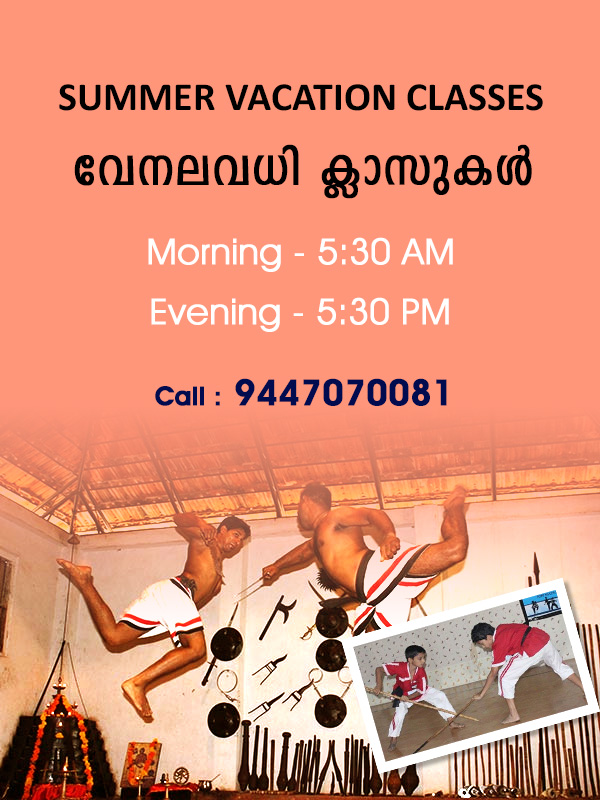Kalarippayattu

” Oh Great Goddess,
Who protects the Kalari tradition,
Long Life “
Kalarippayat is one of the oldest living traditions of martial training, physical culture and self defense in the World. Kalarippayat is derived from two words in Malayalam: Kalari and Payatt. Kalari means ‘the place where any particular art form is taught’. Payatt literally means ‘practice or exercise’. In the present context, it means ‘the traditional style of combat’. It is the Martial Art form of Kerala, the Southern most state of India.
KERALA, THE MOTHER LAND OF KALARIPPAYATTU
Kerala is the beautiful piece of land at the Southern end of India, facing the Arabian Sea on the western side. Throughout history, it was famous for its spices. Culturally and socially it stands apart from all other Indian States. It is one of the most densely populated states in India. According to the 1991 census, the population was 29,632,828. The density is also very high: 747 per sq. km, while the land area is only 1.03% of the whole country. The total land area of the Kerala is only 38863 sq. km.
Kalarippayat is the only form of the most ancient traditional systems of physical culture, self-defense and martial techniques still in existence. The epic hero, LORD PARASURAMA (the incarnation of LORD VISHNU) retrieved Kerala from the sea.
The Origin of Kalarippayattu
The ancient scholars have divided the various art forms into 64 different categories. The art of fighting with weapons is considered to be one among those 64 art forms. Our ancient culture contains very valuable treasures of knowledge dealt with in VEDAS and UPANISHADS. The Dhanurveda, a branch of Yajurveda, described various techniques of martial art, which are considered to be an integrated science for defense and attack. The basic science of Kalarippayat is based on Dhanurveda. Hence historians say that the Kalarippayat must have originated even before 2000B.C. The elder generations still believe that the Kalari Guru is the sage Parasurama himself, who after creating the land of Kerala, taught Kalarippayatt to 21 disciples in order to protect and maintain peace. Lord SIVA is considered to be the father of Kalarippayatt. Parasurama had propagated the Northern style and Sage Agasthya, the Southern style.
Parasurama [he was a Brahmin] commanded the ocean [the Arabian Sea] to move back by hurling a battle-axe and brought into being the land of Kerala. On the east of that land lies the mountain ranges, the Western Ghats, and on the west is the Arabian Sea. Hence the land was termed MALAYALAM, Mala meaning ‘mountain’ and Alam referring to AZHAM or depth, meaning ‘the deep sea’.
The creation of a new land necessitated peopling it. So Parasurama brought in BRAHMINS who were aristocrats in the old days and entrusted the administration and security to them. Such is the responsibility of the ruling class everywhere. The king came from the clan known as KSHATHRIYAS in this country.
Parasurama had a life-long enmity with the Kshathriyas and hence entrusted the sovereignty of the new land to the Brahmins, who were priests by heredity. It is believed that he hand-picked four of the most aristocratic Brahmins, and the four Brahmins families named: ONAMBILLY, VATTETHIRUP, PILLATHANGHI, and ARAPUKAI. They became the four styles and they trained others in the use of various weapons and picked 21 experts from among those trained as warriors and established 21 Kalaris in order to popularize KALARIPPAYATT. These 21 Gurus propagated the art of Kalarippayatt far and wide in Kerala and established 108 Kalaris at different centres.

 Online Class
Online Class